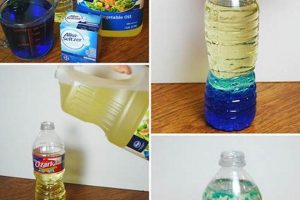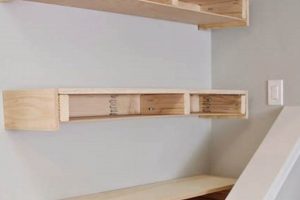The construction of a perimeter barrier using interconnected metal wires, typically galvanized steel, assembled by the homeowner is a common property improvement endeavor. This type of fencing offers a straightforward and relatively inexpensive solution for demarcation and security. An example involves purchasing fencing materials from a home improvement store and, following provided instructions or online tutorials, independently installing posts, framework, and the chain-link mesh itself.
Erecting barriers this way presents multiple advantages, including cost savings compared to professional installation. It also empowers property owners with control over the aesthetic and structural integrity of their boundaries. Historically, the widespread adoption of this method reflects a growing trend toward self-sufficiency and a desire to personalize property features. This approach blends affordability with the capacity to tailor fencing to specific site conditions and individual needs.
Subsequent discussions will delve into the planning phase, required tools and materials, step-by-step installation procedures, common challenges, and maintenance strategies for ensuring longevity and optimal performance. A comprehensive understanding of these factors is crucial for successfully completing such projects.
Essential Guidance for Home-Installed Perimeter Barriers
Successful construction of interconnected metal wire barriers requires careful planning and execution. The following tips provide essential guidance for achieving a durable and aesthetically pleasing result.
Tip 1: Comprehensive Site Assessment: Prior to commencing construction, a thorough evaluation of the terrain is imperative. Identify potential obstacles, such as underground utilities, tree roots, or significant grade changes. Accurate measurements are crucial for determining the quantity of materials required and ensuring proper fence alignment.
Tip 2: Precise Post Placement: Correctly spacing and setting posts is fundamental to the structural integrity of the barrier. Adhere to recommended spacing guidelines, typically eight to ten feet between posts. Ensure posts are plumb and set in concrete footings that extend below the frost line to prevent heaving and shifting due to temperature fluctuations.
Tip 3: Proper Tensioning: Achieving uniform tension on the interconnected metal wire is critical for preventing sagging and maintaining a taut, professional appearance. Utilize tension bars and tension bands to securely attach the wire to the terminal posts. Gradually tighten the tension until the wire is uniformly taut, avoiding over-tensioning, which can damage the framework.
Tip 4: Secure Fastening: Employ appropriate fasteners, such as hog rings or wire ties, to securely attach the interconnected metal wire to the line posts. Space fasteners at regular intervals, typically every twelve to eighteen inches, to ensure uniform support and prevent the wire from separating from the posts.
Tip 5: Gate Installation Considerations: When incorporating a gate, select hardware that is appropriate for the weight and size of the gate. Ensure the gate is properly aligned and swings freely without binding. Install latches and hinges that are durable and resistant to corrosion to ensure long-term functionality.
Tip 6: Galvanized or Coated Materials: For enhanced corrosion resistance and longevity, utilize galvanized or coated metal components. This is especially important in areas with high humidity or exposure to saltwater. Regularly inspect the barrier for signs of rust or corrosion and address any issues promptly to prevent further deterioration.
These guidelines, when diligently applied, contribute significantly to the creation of a secure and lasting perimeter enclosure. Adherence to these principles ensures a functional and aesthetically pleasing result.
The following sections will address common pitfalls and offer solutions for overcoming challenges encountered during the self-installation process.
1. Planning and Layout
Planning and layout are foundational to the successful installation of a perimeter barrier constructed by the homeowner. Erroneous planning invariably leads to material wastage, structural instability, and compromised aesthetics. The accuracy of the initial layout directly dictates the alignment and overall integrity of the fence. For example, failure to account for property line encroachments prior to post installation can result in legal disputes and costly remediation efforts. Similarly, neglecting to identify underground utilities during the planning phase poses a significant safety risk and can lead to service disruptions. The consequences of inadequate planning underscore the necessity for meticulous site assessment and accurate measurements before commencing any physical work.
Furthermore, the planned gate location and swing direction are crucial elements to consider. An improperly positioned gate can impede access, create safety hazards, or detract from the property’s overall appearance. The selection of appropriate hardware and the precise alignment of gate posts are directly dependent on the initial layout. A common example of poor planning is a gate that opens directly onto a public sidewalk, creating a potential obstruction. Conversely, thoughtful planning incorporates the gate seamlessly into the landscape, enhancing both functionality and aesthetic appeal. The planning phase should also encompass an assessment of terrain variations and potential drainage issues, as these factors influence post depth and overall fence height.
In summary, comprehensive planning and layout represent the cornerstone of a self-installed fencing project. Neglecting this critical phase invariably leads to complications and compromises the structural integrity and aesthetic appeal of the final product. Proper planning mitigates risks, optimizes material usage, and ensures compliance with local regulations, ultimately contributing to a successful and enduring perimeter solution. This initial investment of time and effort yields significant dividends in terms of reduced installation time, minimized material costs, and a superior finished product.
2. Post Installation Accuracy
Post installation accuracy is paramount to the success and longevity of any perimeter barrier constructed independently. The stability, alignment, and overall structural integrity of the entire system are directly contingent upon the precise and correct installation of the support posts.
- Vertical Alignment and Plumbness
Ensuring each post is perfectly vertical, or plumb, is not merely an aesthetic consideration; it is fundamental to load distribution and resistance to external forces. Even minor deviations from plumbness accumulate across the fence line, resulting in a leaning or unstable structure. For example, a post that is o
nly slightly off-plumb will exacerbate tension inconsistencies, leading to sagging. Proper use of a level or plumb bob is essential during installation to prevent such issues. - Consistent Post Depth
Maintaining uniform post depth below the frost line is critical in regions experiencing seasonal freezing and thawing. Differential heaving of posts due to inconsistent depth introduces stress points and compromises the fence’s integrity. A deeper post provides greater resistance to frost heave. Instances of shallow post installation frequently result in tilted or uprooted posts, necessitating costly repairs or complete replacement. Adhering to local building codes regarding frost line depth is imperative.
- Proper Concrete Footing
The composition and dimensions of the concrete footing surrounding each post directly affect its stability and resistance to lateral forces. An inadequate concrete mix or insufficient footing diameter fails to provide the necessary support, particularly in areas with loose soil or high winds. A properly sized and reinforced concrete footing anchors the post securely, distributing the load and preventing movement. Skipping this step, or using an insufficient amount of concrete, creates a vulnerability that will weaken the entire barrier.
- Correct Post Spacing
Uniform distance between the posts are important. Over spacing affects fence net to stretch out, cause not durable fence in long term. So the net will easily sag and destroy the fence overall visual.
These facets of post installation accuracy are inextricably linked. A failure in any one area weakens the entire system. Correctly addressing each element during the construction process ensures a durable, secure, and aesthetically pleasing perimeter barrier. Neglecting post installation accuracy compromises the entire project, leading to premature failure and increased long-term maintenance costs.
3. Material Selection
The selection of appropriate materials is a critical determinant of the durability, security, and aesthetic appeal of any perimeter barrier constructed through independent efforts. Informed choices regarding components directly impact the long-term performance and cost-effectiveness of the fencing system. Compromising on material quality or suitability invariably leads to premature failure, increased maintenance demands, and diminished security.
- Gauge and Coating of Chain-Link Fabric
The gauge (thickness) of the chain-link fabric dictates its resistance to physical stress and potential intrusion. Thicker gauges offer superior strength and are less susceptible to cutting or bending. The coating, typically galvanization or PVC, provides protection against corrosion and environmental degradation. For example, in coastal environments, a PVC-coated fabric provides enhanced resistance to saltwater corrosion compared to standard galvanized steel. Opting for an insufficient gauge or inadequate coating compromises the fence’s integrity and reduces its lifespan.
- Post and Framework Material
The material used for posts and framework significantly influences the fence’s structural stability. Galvanized steel is a common choice, offering a balance of strength, affordability, and corrosion resistance. However, alternative materials, such as aluminum or vinyl-coated steel, may be preferred in specific applications. For instance, aluminum is lightweight and highly resistant to corrosion, making it suitable for environments where weight is a concern. The selection should consider factors such as soil conditions, wind loads, and aesthetic preferences. Using substandard materials for posts and framework increases the risk of bending, breaking, or collapsing under stress.
- Fasteners and Hardware
Fasteners and hardware, including tension bands, brace bands, and gate hardware, are essential for securely connecting the various components of the fence. These components should be constructed from durable, corrosion-resistant materials to prevent premature failure. For example, using stainless steel hardware in coastal areas prevents rust and ensures long-term functionality. Choosing inferior fasteners and hardware compromises the structural integrity of the fence and increases the likelihood of components detaching or failing under stress.
- Concrete Mix for Post Footings
The concrete mix used for setting the posts directly impacts their stability and resistance to movement. A properly proportioned mix of cement, aggregate, and water provides the necessary strength and bonding properties. Premixed concrete products offer convenience and consistent quality. For instance, using a high-strength concrete mix in areas with unstable soil provides enhanced support and prevents post shifting. Utilizing an inadequate concrete mix compromises the post’s anchorage and increases the risk of tilting or uprooting.
In summation, meticulous attention to material selection is paramount for constructing a robust and long-lasting perimeter barrier. By carefully considering the gauge and coating of the chain-link fabric, the composition of the posts and framework, the quality of the fasteners and hardware, and the properties of the concrete mix, property owners can ensure a secure and aesthetically pleasing fencing solution. Selecting the appropriate components is an investment in the fence’s long-term performance and a safeguard against premature failure and costly repairs.
4. Tensioning Techniques
Tensioning techniques are integral to the structural integrity and aesthetic quality of a perimeter barrier assembled independently. Proper tensioning ensures the interconnected metal wires are taut, preventing sagging and maintaining a uniform appearance. Inadequate tensioning compromises security and diminishes the overall lifespan of the fence.
- Corner Post and Terminal Post Anchoring
Corner and terminal posts require robust anchoring to withstand the considerable tension exerted by the interconnected metal wires. Insufficient anchoring results in leaning posts and diminished fence stability. One method involves using concrete footings of adequate depth and diameter, as well as bracing with diagonal supports. The absence of proper anchoring at these critical points invariably leads to fence failure under normal weather conditions or applied pressure.
- Use of Tension Bands and Tension Bars
Tension bands and tension bars are essential tools for attaching the interconnected metal wires to the terminal posts. Tension bands secure the wire to the post, while tension bars are woven through the mesh and used to apply tension. Proper installation of these components ensures a uniform and secure connection. Failure to use or improperly installing tension bands and bars leads to uneven tension distribution and potential separation of the mesh from the posts.
- Turnbuckle Tension Adjustment
Turnbuckles provide a mechanism for fine-tuning the tension of the interconnected metal wires. These devices are attached to the brace wires and allow for incremental adjustments to achieve the desired tension level. Accurate tensioning is crucial for preventing sagging and maintaining a professional appearance. Over-tightening turnbuckles can damage the wire or posts, while
under-tightening results in a loose and ineffective barrier. Proper use of turnbuckles requires careful monitoring and adjustments. - Knuckle and Twist Wire Securing
The top and bottom edges of the interconnected metal wires are typically secured with knuckles or twists to prevent unraveling and maintain a clean finish. These techniques involve bending or twisting the wire ends to create a secure and tamper-resistant closure. Improperly secured edges pose a safety hazard and detract from the overall aesthetic appeal. Careful attention to these details contributes to the longevity and professionalism of the fencing solution.
Effective application of these tensioning techniques is paramount to the successful installation of a homeowner-constructed perimeter barrier. By adhering to recommended practices and utilizing the appropriate tools, property owners can ensure a secure, durable, and visually appealing fencing solution. The consequences of neglecting proper tensioning range from aesthetic imperfections to structural failures, underscoring the importance of this critical aspect of fence construction. The investment in proper tools and techniques yields long-term benefits in terms of reduced maintenance costs and enhanced property security.
5. Security Enhancements
Perimeter barriers, particularly those constructed via self-installation methods, often require additional measures to maximize security and deter unauthorized access. The straightforward design of chain-link fencing can be augmented with various enhancements to elevate its protective capabilities. The cause-and-effect relationship is direct: baseline chain-link fencing provides a level of demarcation, while security enhancements build upon this foundation to impede intrusion effectively. Security enhancements serve as crucial components for DIY chain-link installations, transforming a simple boundary marker into a more formidable obstacle. Real-life examples include topping the fence with barbed wire or razor wire, which significantly increases the difficulty and risk associated with climbing over; installing anti-climb mesh, which features smaller openings that prevent a foothold; and integrating security cameras to monitor the perimeter.
Further security improvements can involve reinforcing the fence posts with concrete to prevent them from being easily uprooted or circumvented. Embedding the base of the fence deeper into the ground also restricts the ability to dig underneath it. Consider employing gate hardware with robust locking mechanisms, such as padlock hasps or electronic access control systems. These upgrades are particularly important for high-security applications or properties located in areas prone to vandalism or theft. Motion-activated lighting systems, strategically positioned along the fence line, serve as a powerful deterrent, illuminating potential intruders and alerting occupants to suspicious activity. Employing these measures cumulatively provides layered security, rendering the DIY chain-link fence a more challenging target.
In summary, integrating security enhancements into a self-installed chain-link fence is a pragmatic approach to bolstering property protection. The understanding of cause and effect, coupled with the application of suitable countermeasures, significantly improves the fence’s ability to deter unauthorized entry. While challenges may arise during the installation of these enhancements, the resulting increase in security underscores the importance of considering and implementing appropriate measures. This holistic approach aligns with the objective of creating a secure perimeter that effectively safeguards property and assets.
Frequently Asked Questions About Chain-Link Perimeter Barriers Assembled Independently
This section addresses common inquiries regarding the planning, installation, and maintenance of perimeter barriers constructed using interconnected metal wire, offering clarification on critical aspects of the process.
Question 1: What constitutes the typical lifespan of a chain-link perimeter barrier installed independently?
The longevity of such a barrier is contingent upon material quality, installation precision, and environmental conditions. Properly galvanized steel components, correctly installed and maintained, can endure for 15 to 20 years or longer. However, exposure to corrosive elements or subpar installation practices can significantly reduce this timeframe.
Question 2: What are the primary regulatory considerations when erecting a perimeter barrier constructed independently?
Compliance with local zoning ordinances and building codes is essential. Regulations often dictate permissible fence height, setback requirements from property lines, and restrictions on materials. Prior to commencing construction, consulting with municipal authorities to ascertain applicable regulations is advisable.
Question 3: What tools are indispensable for the successful assembly of a chain-link perimeter barrier?
Essential tools include a post-hole digger or auger, a level, a tape measure, a tensioning tool, pliers, and a socket set. The availability of specialized tools facilitates efficient and accurate installation, mitigating potential complications.
Question 4: How does one effectively mitigate the risk of corrosion in a chain-link perimeter barrier?
Employing galvanized or PVC-coated components is crucial for corrosion resistance. Regular inspection for signs of rust and the prompt application of protective coatings to affected areas extend the barrier’s lifespan. Furthermore, avoiding direct contact with corrosive substances is advisable.
Question 5: What constitutes an appropriate post spacing interval for a chain-link perimeter barrier?
A post spacing of eight to ten feet is generally recommended for standard applications. However, this interval may need adjustment based on terrain conditions, wind loads, and specific security requirements. Maintaining consistent spacing is critical for structural integrity.
Question 6: How should one address variations in ground elevation during the installation of a chain-link perimeter barrier?
Variations in elevation can be accommodated through stepping or racking the fence. Stepping involves creating vertical offsets between sections, while racking involves gradually adjusting the angle of the fence to conform to the terrain. Careful planning and execution are essential for maintaining a consistent appearance.
These answers provide fundamental guidance on the intricacies of erecting a perimeter barrier independently. The proper application of these principles promotes a robust and enduring fencing solution.
The following section will explore advanced techniques for optimizing both the functionality and aesthetics of perimeter barriers constructed through independent means.
DIY Chain Link Fence
This exposition has explored the multifaceted aspects of erecting a perimeter barrier from interconnected metal wires through independent effort. Key focal points encompassed meticulous planning, precise post installation, appropriate material selection, proper tensioning methodologies, and the strategic integration of security enhancements. The durability and efficacy of such a boundary are inextricably linked to adherence to these fundamental principles. Successfully navigating the nuances of this process requires a comprehensive understanding of both the practical techniques involved and the regulatory lands
cape governing such installations.
The diligent application of the knowledge herein presented empowers property owners to create secure, enduring, and aesthetically acceptable boundaries. While this undertaking presents inherent challenges, meticulous attention to detail and a commitment to best practices will mitigate potential complications and ultimately yield a cost-effective and satisfying result. Further investigation into local building codes and consultation with experienced professionals are strongly encouraged before initiating any self-installation endeavor.







